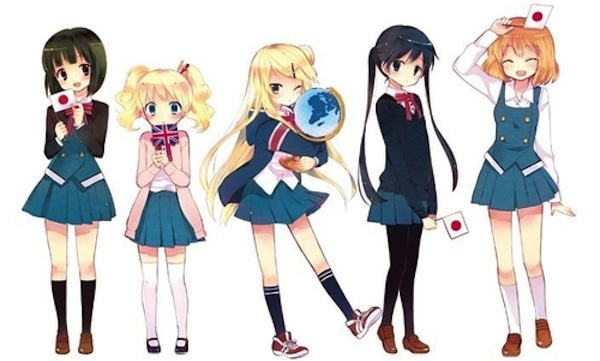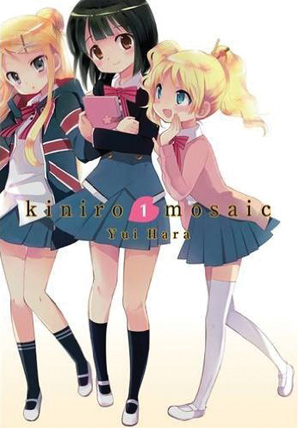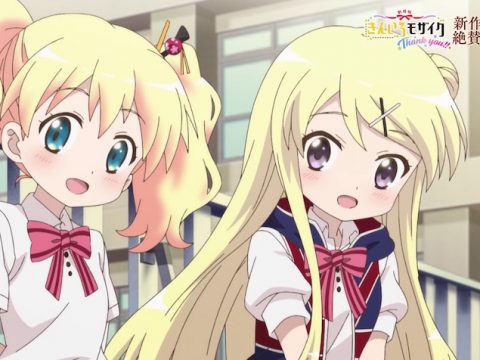
“As the cherry blossoms bloomed, an English girl came to our house.”
In middle school, Shinou Oomiya went overseas and became pen pals with Alice, the daughter of her foster family. (“Her name is Alice.” “Alice? The Alice? From Wonderland?!”) We see flashbacks to Shinou’s days in England, with Shinou and Alice attempting to communicate despite only being able to say “Hello” and “Konnichiwa,” respectively.
Then suddenly, Alice comes to Japan, and Shinou’s friends Youko and Aya finally get to meet the “golden-haired angel”! Adorable and petite, all Alice has to do is use chopsticks or sit Japanese-style to fascinate everyone around her. Debates rage over whether Alice reminds them more of a bunny, a cat, or a hamster. While Alice entertains everyone with her Britishness, Shinou practices her English with less than successful results.
While on the surface it’s just another four-panel manga about cute girls (and, of course, a ditzy teacher; gotta have a ditzy teacher), Kiniro Mosaic is more clever and creative than most. With its theme of foreignness,  it almost comes off as a parody of weeaboos obsessed with Japanese culture, such as the scenes when Shinou pretends to read English newspapers she actually can’t read, or wants to die her hair blonde, or says she loves “European culture” but can’t place Europe on a map. Later we meet Karen Kujou, a half-English girl, who embodies a different image of foreigners, talking in broken Japanese and saying things like “Japanese uniform very cute” and “Are you ninja? Walk up walls?”
it almost comes off as a parody of weeaboos obsessed with Japanese culture, such as the scenes when Shinou pretends to read English newspapers she actually can’t read, or wants to die her hair blonde, or says she loves “European culture” but can’t place Europe on a map. Later we meet Karen Kujou, a half-English girl, who embodies a different image of foreigners, talking in broken Japanese and saying things like “Japanese uniform very cute” and “Are you ninja? Walk up walls?”
Despite the inevitable clichés like the weight jokes and the closeted lesbian girl, it’s cute stuff, and the jokes generally hit home even when they don’t have anything to do with culture. Would it be interesting to interrogate the manga’s wholesale, fetishistic equation of “blondeness” with “the West”? Well, sure, but you’d be missing a very funny manga. The Yen Press edition includes nine pages of translation notes.
Recommended.
publisher:
Yen Press
story and art: Yui Hara
rating: 13+


![Yokohama Station SF [Manga Review] Yokohama Station SF [Manga Review]](https://otakuusamagazine.com/wp-content/uploads/2023/11/Yokohama-Station-SF-v2-crop2-480x360.jpg)
![Manner of Death [Review] Manner of Death [Review]](https://otakuusamagazine.com/wp-content/uploads/2023/10/manner-of-death-v2-crop-480x360.jpg)
![Origin [Review] Origin [Review]](https://otakuusamagazine.com/wp-content/uploads/2023/10/origin-10-crop-480x360.jpg)
![Lady Oscar: The Rose of Versailles [Anime Review] Lady Oscar: The Rose of Versailles [Anime Review]](https://otakuusamagazine.com/wp-content/uploads/2021/11/RoV_Vol2_Front_CoverArt_V1-480x360.jpg)

![Kirby Manga Mania [Manga Review] Kirby Manga Mania [Manga Review]](https://otakuusamagazine.com/wp-content/uploads/2021/07/kirby-manga-mania-v1-16-9-480x360.jpg)